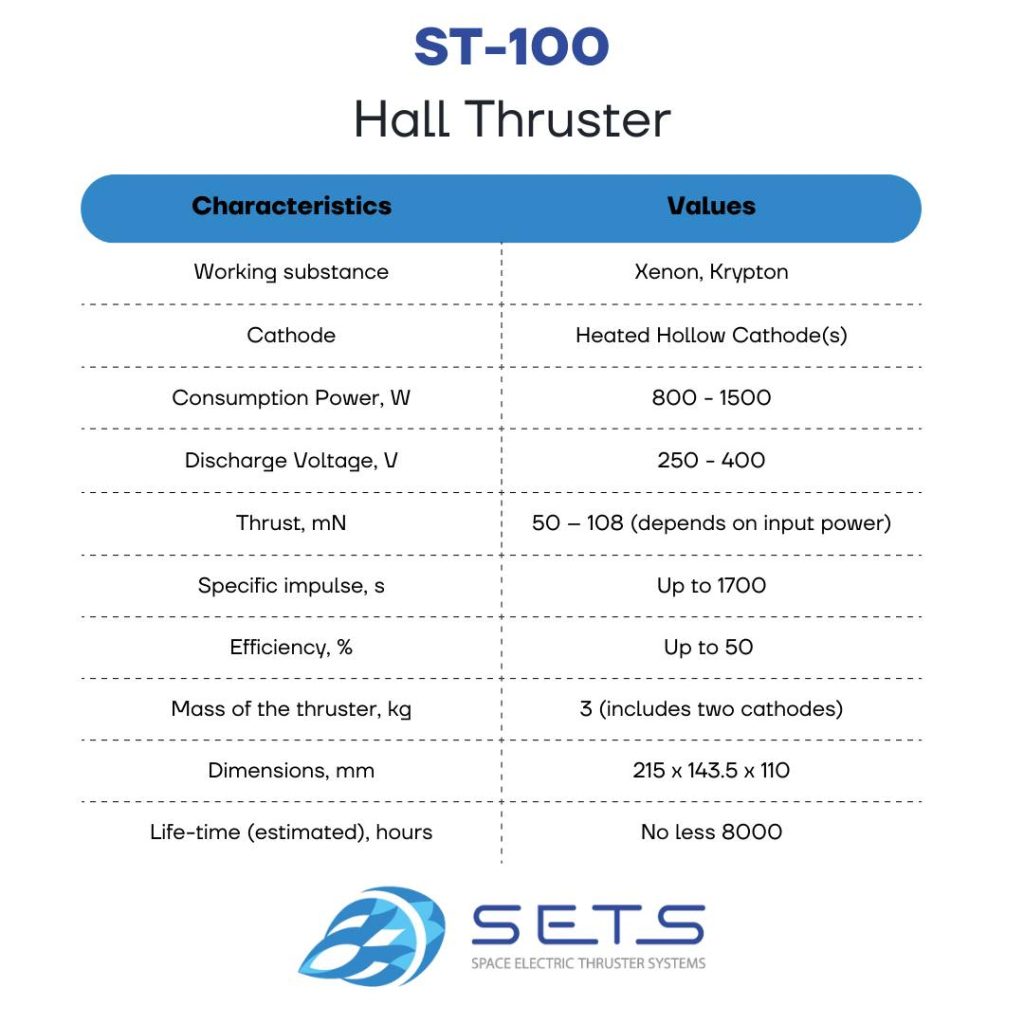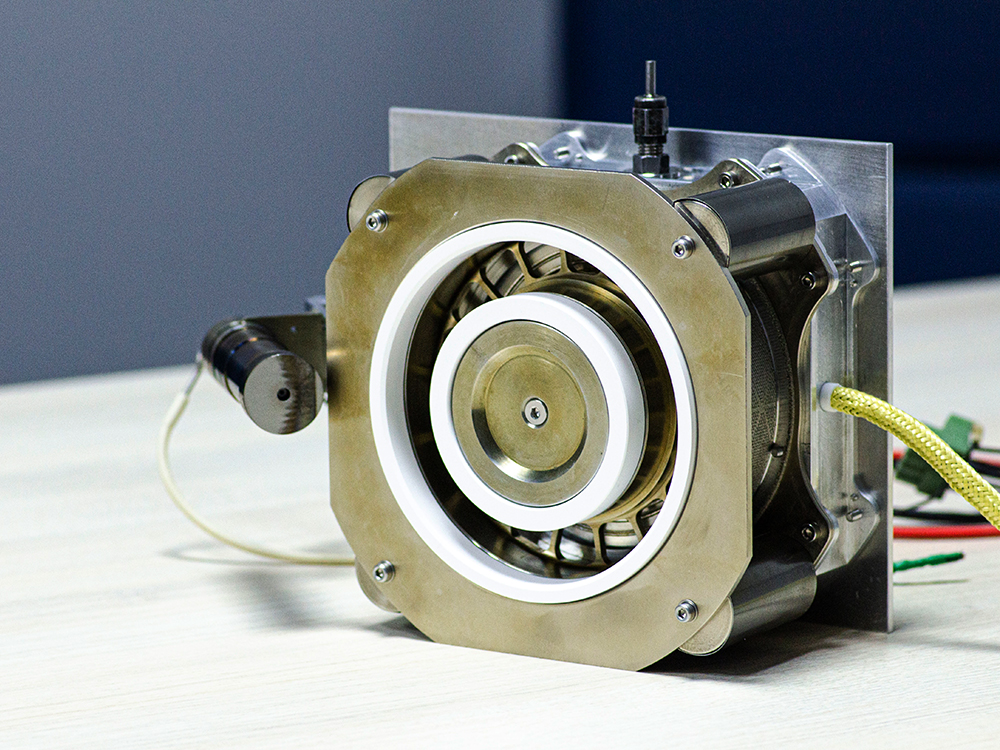In response to the escalating demand for intermediate and high-power thrusters for large satellites, SETS is proud to present its latest innovation – the 1.5 kW ST-100 Hall-Effect Thruster designed for a wide range of spacecraft applications.
Its powerful capabilities allow a spacecraft to maintain orbital parameters, perform orbital manoeuvres, operate on geostationary satellites, and even perform deep space missions, distinguishing it as a key player in the evolution of space propulsion!
Leading in the market of thrusters for large satellites
In the realm of in-space mobility solutions, SETS stands out by offering end-to-end services and on-site capabilities for testing high-power thrusters tailored to large satellites. At the heart of our product offering is the ST-100, a 1.5 kW Hall-Effect thruster. This technology is instrumental in in-orbit servicing, executing precise orbital manoeuvres, and enabling deep space missions.
Recent years have witnessed a substantial shift in satellite propulsion dynamics. Notably, between 2016 and 2020, 40% of satellites operated without propulsion systems. However, that proportion has since jumped to almost 90%. Major constellations such as Starlink, OneWeb, ICEYE, Capella, BlackSky, and SkySat are at the forefront of this shift.
The market for thrusters is tightly contested, with no more than six New Space companies participating which are able to develop over-kilowatt thrusters. With market projections estimating that the market will grow to $60-80 million by 2024/2025, the ST-100 presents an attractive opportunity in this flourishing landscape!
Implementation Area: ST-100 thrusters for large Satellites
As SETS CEO Viktor Serbin notes, by the end of 2023, electric propulsion (EP) had become the dominant technology in the satellite propulsion market, equipping more than 80% of satellites launched last year. The EP market showed particular growth in the SmallSat and larger satellite niche.
The majority of New Space companies are focused on developing EP, with 60% exclusively working on electric thrusters, and 84% including at least one EP system in their product line. This commitment to EP technologies is reflected in the industry’s investment activity, with $320 million (73%) of the total $438 million raised by the 44 companies in the market since 2014 allocated to the development of EP systems.
Upcoming interplanetary missions, including those exploring planets like Mercury or Mars and those involving sample return missions, demand sophisticated propulsion systems. EP will also play a crucial role in space tugs, de-orbiting tugs, and refuelling spacecraft. It has been a staple in satellite operations since the 1970s, employed for tasks such as station-keeping and orbit raising, as well as serving as the primary means of propulsion. Initially utilised mainly in telecommunications and science missions, its scope is expanding to encompass earth observation, navigation, and the removal of orbital debris.
An illustrative example of successful Hall Effect thruster use is the SMART-1 mission, where the PPS 1350 Hall Effect thruster from SNECMA was utilised to reach the Moon. SMART-1, the European Space Agency’s inaugural mission to the Moon, served as a technology test for solar-electric propulsion, communication technologies, and miniaturised science instruments. The technology tests proved successful, culminating in the deliberate crash of the spacecraft on the Moon in September 2006.
Other examples include:
The ARTEMIS Mission
In 2001, the European Space Agency’s ARTEMIS (Advanced Relay and Technology Mission Satellite) achieved a significant milestone by conducting the first European EP flight demonstration. It successfully demonstrated EP’s capabilities for orbit raising, allowing the satellite to its final orbit after encountering a launcher anomaly.
Adoption by Satellite Manufacturers (From 2000 Onwards)
Starting in 2000, Hall Effect thrusters gained increasing adoption by prominent satellite manufacturers such as Alcatel Space and Airbus DS. Once a satellite manufacturer invested in integrating a specific EP technology, there was a compelling incentive to stick with the same technology to avoid repeating integration investments. This trend has led to a continuous rise in the utilisation of Hall Effect thrusters on telecom platforms.
Space System Loral
In 2004, Space System Loral incorporated SPT-100 Hall Effect Thrusters for station-keeping purposes. Operating at 1.5 kW, each SPT-100 generated 0.083N of thrust, proving effective at maintaining the satellite’s position in orbit.
Lockheed Martin’s AEHF Satellite (2010)
In 2010, Lockheed Martin’s Advanced Extremely High Frequency (AEHF) satellite faced an anomaly with its main chemical propulsion system. To complete its orbit raising, it deployed Hall Effect thrusters originally intended for station-keeping, showcasing the versatility and reliability of this technology in addressing unexpected challenges.
For more than a decade, European satellite manufacturers have relied on EP for the station-keeping of their platforms. Notably, the Eurostar 3000 series produced by Airbus and the Spacebus 4000 series produced by Thales Alenia Space have accumulated thousands of operational hours utilizing EP. This extensive and successful track record has significantly bolstered confidence in the reliability and effectiveness of EP technology within the European satellite industry.
These examples illustrate the diverse applications and success stories of Hall Effect thrusters in satellite missions, from overcoming malfunctions to ensuring efficient orbit maintenance and raising.
Our product line is strategically aligned with this growing demand and adheres to the dominant trend of EP applications. To secure a substantial market share, we have developed a line of EP systems based on Hall Effect technology, covering a broad spectrum of satellite classes, from microsats weighing over 50 kg to large satellites weighing several tons.
In this case, the ST-100 Hall Effect Thruster holds immense potential for cost-conscious missions, positioning itself as the leading choice for a majority of current commercial and government missions. Moreover, the ST-100 offers a solution to the perpetual problem of minimising the amount of propellant spacecraft have to carry to reach their final orbits and achieve their desired operational lifetime, thanks to its high specific impulse. This is particularly beneficial in orbit-raising manoeuvres for GEO telecommunication spacecraft. Moreover, the high controllability of ST-100 makes it ideal for missions with stringent requirements.
Confronting pressing challenges in space debris dynamics with the ST-100
According to a report by Satelliteprome, the number of satellite launches has been on the rise since 2020, reaching 2552 last year. This surge in launches has brought about significant challenges, such as the urgent need for effective traffic monitoring and space debris reduction. The European Space Agency estimates that there are currently approximately 34,000 objects larger than 10 cm, 900,000 objects ranging from 1 cm to 10 cm, and an astonishing 128 million objects between 1 mm and 1 cm cluttering Earth’s orbit.
Acknowledging the pivotal role of propulsion systems in overcoming these challenges, we have introduced a comprehensive product line designed to accommodate satellites across Microsat to Large classes. Our flagship offering is the 1.5 kW ST-100 Hall-Effect Thruster, expertly engineered for large satellites and specifically catering to in-orbit servicing and precise orbital manoeuvres.
Key Features of the ST-100
Here are the THREE key features of the ST-100 Hall-Effect Thruster:
- For its power of 1.5 kW, the thruster shows excellent performance with a thrust of up to 107 mN.
- The thruster is designed using technological solutions successfully tested in space on board a spacecraft.
- The ST-100 is engineered for a diverse range of spacecraft applications (including MEO, GEO and deep space missions, scientific missions or any other space vehicles).
Technical characteristics of the ST-100
The ST-100 Hall-Effect Thruster weighs only three kg, including two cathodes, and its estimated service life is at least 8,000 hours. For other technical characteristics of the ST-100, see the image below.

Innovative construction with 3D printing
In manufacturing the ST-100 Hall-Effect Thruster, we have taken a bold step forward by incorporating state-of-the-art 3D printing technology. This innovative approach offers THREE main advantages:
- 1) Speeding up manufacturing:
- 3D printing technology streamlines the manufacturing process, reducing production timelines and enhancing efficiency.
- 2) Impact on pricing:
- The utilisation of 3D printing offers significant cost savings, making the ST-100 a budget-friendly solution without compromising performance.
- 3) Precision in design:
- 3D printing allows for intricate and precise designs, optimising the thruster’s performance and ensuring reliability in space missions.
Laboratory testing confirms the ST-100’s reliability
The ST-100 Hall Effect Thruster’s superior performance stems from our meticulous design and construction approach aimed at achieving high parameters, reliability, and a maximum lifespan. Increasing the ST-100’s durability and lifespan was our priority, and we achieved it through a number of innovative enhancements.
Our extensive expertise in cathode development allowed us to improve reliability by using materials that have not been used in cathodes before. To further fortify the thruster, we also applied magnetic shielding to the accelerating channel’s walls. This resulted in a remarkable reduction in the erosion of the channel’s walls, significantly extending the thrusters’ lifetime.
In addition, we conduct full-cycle testing for our products. The extensive testing we have put the ST-100 through has allowed us to identify its optimal performance settings, including light weight, low power consumption, and high efficiency, with an estimated lifetime of no less than 8,000 hours.
Our work to make our thruster the best on the market continues today!





